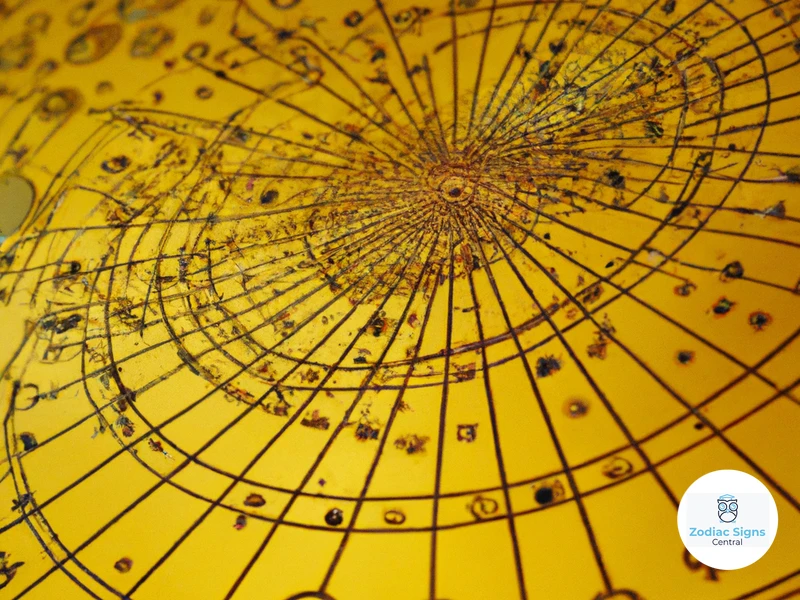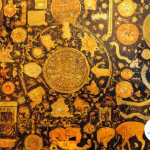Throughout history, numerous scholars and thinkers have made significant contributions to various fields of study, shaping our understanding of the world. One such influential figure is Ptolemy, an ancient astronomer, mathematician, and astrologer who lived during the 2nd century AD in Alexandria, Egypt. Ptolemy’s work revolutionized the field of astrology, leaving an indelible mark on its concepts and techniques. This article delves into the fascinating contributions of Ptolemy to ancient astrology, exploring his background, his groundbreaking ideas, and his lasting impact on the field. From his mathematical and astronomical achievements to his influential works like the Almagest, join us as we uncover the extraordinary contributions of Ptolemy and their significance in the realm of astrology.
Ptolemy’s Background and Influence

Ptolemy, an ancient scholar hailed from Alexandria, Egypt, was an influential figure in the development of astrology. His work and ideas shaped the field in significant ways, leaving a lasting impact on astrological concepts and techniques. Ptolemy’s background itself played a crucial role in his influential status. He was born in the Hellenistic period and grew up in a city known for its rich intellectual and cultural environment. Ptolemy was deeply influenced by the knowledge and ideas circulating in Alexandria during his time, which allowed him to build upon existing theories and develop his own unique perspectives. His education and access to libraries and scholars further enhanced his understanding and mastery of various subjects, particularly mathematics and astronomy. Ptolemy’s mathematical inclinations would become a driving force in his contributions to astrology, as he sought to combine rigorous calculations with celestial observations. His work in mathematics and astronomy laid the foundation for his astrological theories, giving them a solid scientific basis. Ptolemy’s influence extended beyond his time, as his works were widely studied and translated into various languages, ensuring their preservation and dissemination across different civilizations. The legacy of Ptolemy’s background and influence remains intertwined with the history and evolution of astrology, continuing to shape astrological practices and interpretations today.
1. Early Life and Education
Ptolemy’s early life and education played a crucial role in shaping his path as a scholar and his contributions to astrology. Born in Alexandria, Egypt, during the 2nd century AD, Ptolemy grew up in a vibrant intellectual environment that fostered a deep appreciation for knowledge and learning. Little is known about his early life, but it is believed that Ptolemy received a comprehensive education in various disciplines, including mathematics, philosophy, and astronomy. Alexandria, with its renowned library and esteemed scholars, provided Ptolemy with access to a wealth of information and resources, allowing him to expand his knowledge and develop his intellectual abilities. His education in mathematics, in particular, laid the foundation for his future work. Ptolemy’s training in mathematics equipped him with the analytical and quantitative skills necessary for his astronomical observations and calculations. It was during this formative period that Ptolemy began his exploration into the celestial realm, laying the groundwork for his later contributions to astrology. While specific details about his education are scarce, Ptolemy’s early life undoubtedly played a pivotal role in nurturing his intellectual curiosity and facilitating his journey toward becoming one of the most influential figures in the history of astrology.
2. Ptolemy’s Work in Mathematics and Astronomy
Ptolemy’s work in mathematics and astronomy was foundational to his contributions to astrology. He made significant strides in these fields, which served as the basis for his astrological theories. In mathematics, Ptolemy’s most famous work was his treatise on trigonometry, known as the “Almagest.” This comprehensive compilation of mathematical knowledge included theorems and formulas for calculating angles, lengths, and distances, which were crucial for celestial observations and calculations. Ptolemy’s advancements in trigonometry provided the mathematical tools necessary to map the movements of celestial bodies accurately.
In astronomy, Ptolemy refined and expanded upon existing models of the solar system. He proposed a geocentric model, where Earth was believed to be at the center, with the Sun, Moon, planets, and stars revolving around it in perfect circles. This model, outlined in his work “Planetary Hypotheses,” became widely accepted for over a thousand years and influenced astronomical thinking during the medieval and Renaissance periods.
Ptolemy’s meticulous observations and calculations allowed him to develop accurate planetary tables, detailing the positions of celestial bodies at specific times. These tables, known as the “Ptolemaic Table of Planetary Positions,” became invaluable references for astrologers, enabling them to determine the exact positions of planets at any given moment for horoscopes and astrological interpretations.
Ptolemy’s work on aspects, the dynamic relationships between planets, contributed to the interpretation of astrological charts. He defined various aspects, such as conjunctions, trines, squares, and oppositions, and provided insights into their effects on individuals’ lives and personalities. Ptolemy’s interpretations of these aspects brought the mathematical precision of his astronomical calculations into the realm of astrology, allowing astrologers to assess the harmonious or challenging interactions between different planets in a birth chart.
Ptolemy’s contributions in mathematics and astronomy laid the groundwork for his revolutionary ideas in astrology. His meticulous observations, mathematical calculations, and refined models expanded the understanding of the celestial world and its influence on human lives. The impact of Ptolemy’s work in mathematics and astronomy can still be felt in contemporary astrology practice, where the precise measurement of planetary positions and the analysis of planetary aspects continue to play a significant role in astrological interpretations.
Ptolemy’s Astrological Concepts
Ptolemy’s astrological concepts revolutionized the understanding of celestial influences on human lives. One of his major works, the Almagest, explored the significance of the planets and their movements in astrology. Ptolemy emphasized the geocentric model, which posited that everything in the cosmos revolved around the Earth. This belief played a pivotal role in his astrological concepts, as it influenced his understanding of how different celestial bodies exerted their influences on human affairs. Ptolemy also introduced the concept of the four cardinal points: the Ascendant, Descendant, Midheaven, and Nadir, which corresponded to the four major angles in a birth chart. These points were crucial in determining the zodiac sign rulerships, which Ptolemy believed affected the temperament and characteristics of individuals. The combination of the geocentric model, the four cardinal points, and zodiac sign rulerships formed the foundation of Ptolemy’s astrological concepts. These ideas continue to be influential in contemporary astrology, shaping interpretations of planetary influences and the dynamics of celestial transits. To explore further, you can learn about the effects of Mercury in different houses or the impact of Saturn transits on mental and emotional wellbeing.
1. The Almagest and Astrological Significance
The Almagest, a monumental work by Ptolemy, holds significant astrological significance due to its comprehensive study of the celestial bodies and their movements. This influential text served as both an astronomical and astrological treatise, providing insights into the motions of the planets and their impact on human affairs. Ptolemy meticulously documented the positions of the planets and their paths across the sky, ultimately creating a geocentric model that placed Earth at the center of the universe. The Almagest played a crucial role in shaping astrological practices, as it provided the foundation for determining planetary positions at specific times and locations. This allowed astrologers to calculate accurate birth charts and interpret the influence of celestial bodies on an individual’s life.
Ptolemy’s observations and calculations in the Almagest laid the groundwork for astrological predictions and the understanding of the planets’ effects on various aspects of human existence. Astrologers began to associate specific planetary alignments with corresponding events and characteristics in individuals’ lives. For example, they linked the position of the Sun at the time of birth to the individual’s personality traits and potential life path. The Almagest provided a comprehensive framework that enabled astrologers to delve deeper into the intricacies of planetary movements and their influence on humanity.
While the Almagest was primarily an astronomical text, its astrological significance cannot be overstated. It revolutionized the way astrologers approach the interpretation of planetary positions and their effects on human lives. By establishing a geocentric model, Ptolemy emphasized the Earth’s central role and the interconnectedness of celestial bodies with human destinies. The Almagest laid the foundation for subsequent astrological works, shaping the field for centuries to come. Its impact can still be felt today, as astrologers continue to study and draw inspiration from Ptolemy’s insights to gain a deeper understanding of planetary influences.
2. Geocentric Model and its Impact on Astrology
The geocentric model, proposed by Ptolemy, had a profound impact on astrology and how astrologers understood the movements of celestial bodies. According to this model, the Earth was believed to be at the center of the universe, with all other celestial bodies, including the Sun, Moon, planets, and stars, revolving around it in perfect circular orbits. The geocentric model provided a framework for astrologers to interpret the positions and movements of celestial bodies in relation to Earth and its impact on human lives. The belief in this model allowed astrologers to conceptualize the concept of planetary transits, which refers to the movement of planets in relation to Earth’s position at a particular time. This understanding became an integral part of astrological predictions and interpretations.Since the planets were all believed to revolve around the Earth, their positions and alignments were seen as significant indicators of potential events and influences on individuals’ lives. For example, the dynamics of a Mars square Mercury transit, where Mars and Mercury appear to form a challenging aspect in the sky, could be interpreted by astrologers to signify potential conflicts in communications and mental processes. The geocentric model provided a foundational understanding for astrologers to analyze and interpret these celestial phenomena, allowing for more nuanced and accurate astrological readings. While the geocentric model is no longer the prevailing scientific view, its impact on astrology remains significant, as many astrologers still incorporate its principles and interpretations into their practices today, striving to uncover the profound connections between celestial movements and human experiences.
3. Four Cardinal Points and Zodiac Sign Rulerships
In astrology, the four Cardinal Points hold significant importance, and Ptolemy’s contributions in understanding their influence on zodiac sign rulerships are noteworthy. The four Cardinal Points, also known as the four angles, include the Ascendant (also referred to as the “Rising Sign”), the Descendant, the Midheaven, and the Imum Coeli. Ptolemy recognized these points as key indicators in a natal chart, as they represent the intersection of the celestial and earthly realms. The Ascendant marks the beginning of the first house, symbolizing the individual’s persona and how they present themselves to the world. The Descendant, directly opposite the Ascendant, represents relationships and partnerships. The Midheaven signifies one’s aspirations, career, and public image, while the Imum Coeli reflects the foundations of the self, including one’s roots and personal life. Ptolemy’s understanding of the Cardinal Points led to the development of the concept of zodiac sign rulerships. Each of the four angles is associated with a specific zodiac sign, bringing its qualities and characteristics into prominence in a person’s life. For instance, if Aries is the sign associated with the Ascendant, the individual may exhibit assertiveness, ambition, and a pioneering spirit. Ptolemy’s recognition of the interplay between the Cardinal Points and the zodiac sign rulerships enhances astrological interpretations and provides valuable insights into an individual’s life path and energetic disposition. Understanding the significance of these Cardinal Points and their connection to zodiac sign rulerships allows astrologers to delve deeper into a person’s chart, uncovering individual strengths, challenges, and life patterns. So, Ptolemy’s contributions in this field continue to shape modern astrological practices, providing a framework for analyzing and interpreting the complexities of an individual’s astrological profile. Click here for more information on the dynamics of Mars square Mercury transit.
Ptolemy’s Contributions to Astrological Techniques

Ptolemy’s contributions to astrological techniques were groundbreaking and have had a profound influence on the field. One of his notable contributions was the development of the Ptolemaic Table of Planetary Positions, a comprehensive record of the positions of celestial bodies at specific times. This table provided astrologers with valuable information to calculate planetary placements and make accurate predictions. Ptolemy’s precise calculations and systematic approach revolutionized the practice of astrology, ensuring consistency and accuracy in analyzing planetary influences.
Another significant contribution by Ptolemy was the formulation of Ptolemaic Aspects and their interpretations. Aspects refer to the angular relationships between planets, which influence their interactions and energies. Ptolemy identified five major aspects, including the conjunction, sextile, square, trine, and opposition. Each aspect brought a unique dynamic to the astrological chart and held specific meanings and influences. Ptolemy’s insightful interpretations of aspects provided astrologers with valuable tools to understand the complexities of planetary interactions and their impact on an individual’s life.
Additionally, Ptolemy’s work emphasized the significance of houses in astrology. Houses represent different areas of life and provide context for understanding how planetary energies manifest in specific areas of one’s life. Ptolemy classified the houses and assigned each zodiac sign to rule over a particular house, which further refined astrological interpretations. This conceptual framework provided a more comprehensive understanding of how celestial placements influenced various aspects of an individual’s life, enabling astrologers to provide nuanced readings and predictions.
Ptolemy’s contributions to astrological techniques laid the groundwork for many of the practices and tools used in astrology today. His meticulous calculations, identification of aspects, and emphasis on houses have become fundamental pillars of astrological analysis. These techniques continue to be utilized and expanded upon by contemporary astrologers, ensuring Ptolemy’s ongoing relevance and impact in the field of astrology.
1. Ptolemaic Table of Planetary Positions
Ptolemy’s contributions to astrology included the development of the Ptolemaic Table of Planetary Positions, which revolutionized the field and allowed for more accurate calculations and predictions. This table provided a detailed record of the positions of the planets in relation to the Earth at specific dates and times. By documenting the precise celestial coordinates of each planet, astrologers could determine their positions in different zodiac signs and houses. This information was crucial for constructing birth charts and making astrological forecasts.
The Ptolemaic Table of Planetary Positions organized the data in a systematic manner. It included columns for the planet’s name, zodiac sign, degree, and minute of its position. This layout allowed astrologers to quickly identify and interpret the planetary placements in a chart. For example, if someone’s birth chart indicated that their Moon was positioned at 12 degrees Taurus, astrologers could analyze the implications of this placement such as the individual’s emotional nature, instincts, and relationship with their mother.
Ptolemy’s Table of Planetary Positions enabled astrologers to make precise calculations, aiding them in predicting future celestial events and interpreting their impact on an individual’s life. This advance in astrological technique added a level of accuracy and specificity to astrological readings, enhancing their credibility and popularity.
It is important to note that while the Ptolemaic Table of Planetary Positions was a milestone in ancient astrology, modern astrologers have developed more sophisticated and streamlined methods of recording and interpreting planetary positions. However, Ptolemy’s innovation laid the groundwork for the evolution of accurate planetary data, which remains an essential component of astrology to this day.
2. Ptolemaic Aspects and their Interpretations
Ptolemy’s contributions to astrology encompassed various techniques and concepts, including his groundbreaking work on aspects and their interpretations. Aspects refer to the geometric angular relationships between celestial bodies in astrology. Ptolemy classified five major aspects: conjunction, opposition, trine, square, and sextile. He assigned specific meanings and interpretations to each aspect based on their angular separations.
1. Conjunction: A conjunction occurs when two celestial bodies align at the same degree or very close to each other. Ptolemy considered this aspect to be the most potent, signifying a blending or merging of energies between the planets involved. Conjunctions were believed to intensify the influence of the planets and create a strong emphasis on the qualities they represent.
2. Opposition: An opposition occurs when two celestial bodies are approximately 180 degrees apart. Ptolemy associated this aspect with a sense of tension, polarity, and conflict. Oppositions were believed to highlight contrasting energies between the planets involved, often leading to a need for balance and integration.
3. Trine: A trine occurs when two celestial bodies are approximately 120 degrees apart. Ptolemy deemed this aspect harmonious, representing ease, flow, and positive interaction. Trines were considered beneficial, indicating opportunities for growth, creativity, and favorable outcomes.
4. Square: A square occurs when two celestial bodies are approximately 90 degrees apart. Ptolemy viewed this aspect as challenging and dynamic, symbolizing the need for adjustment and overcoming obstacles. Squares were associated with tension, friction, and the potential for conflict, urging individuals to find solutions and create change.
5. Sextile: A sextile occurs when two celestial bodies are approximately 60 degrees apart. Ptolemy regarded this aspect as harmonious but less potent than the trine. Sextiles were seen as facilitating opportunities for growth, connections, and favorable circumstances, often requiring some effort to seize their potential.
Ptolemy’s interpretations of aspects provided astrologers with a framework for understanding the dynamics and interactions between celestial bodies in a birth chart. These interpretations influenced astrological analysis and delineation, helping practitioners to determine the complex interplay of planetary energies and their impact on individual lives. The study and interpretation of Ptolemaic aspects continue to be a fundamental component of modern astrology, shaping the way astrologers comprehend and interpret celestial alignments.
3. Ptolemaic Houses and their Significance
Ptolemy’s understanding of astrological houses and their significance was another remarkable contribution to the field. According to Ptolemy, the division of the celestial sphere into twelve houses was a fundamental aspect of astrology. Each house represented a specific area of life and was associated with different themes, experiences, and influences. Ptolemy believed that the houses played a crucial role in determining the quality and outcome of various life events. To assess the influence of the houses, Ptolemy considered their position in relation to the Ascendant, the point that marked the eastern horizon at the moment of a person’s birth. The Ascendant became the starting point of the first house, with each subsequent house succeeding it in a counter-clockwise direction. Ptolemy associated specific meanings and interpretations with each house. For example, the first house represented the individual’s personality and appearance, the second house dealt with finances and possessions, the third house focused on communication and siblings, and so on. Ptolemy’s delineation of the houses and their significance provided astrologers with a framework for understanding the different areas of life and their interactions with planetary influences. This understanding continues to be an integral part of modern astrology, guiding astrologers in their interpretations and enhancing the depth and accuracy of their readings.
Ptolemy’s Influence on Western Astrology
Ptolemy’s influence on Western astrology cannot be overstated. His works, such as the “Tetrabiblos,” had a profound impact on the development and understanding of astrology in the Western world. One significant aspect of Ptolemy’s influence was the transmission of his works to the Islamic world during the Islamic Golden Age. Islamic scholars, particularly during the 8th to 12th centuries, eagerly embraced Ptolemy’s teachings and incorporated them into their own astrological works. This exchange of knowledge helped to preserve and further develop Ptolemaic astrology, introducing new interpretations and techniques. However, it wasn’t until the European Renaissance, several centuries later, that Ptolemy’s works experienced a revival in the Western world. During this period, there was a renewed interest in ancient scholarship, and Ptolemy’s writings were rediscovered and studied by European scholars. His ideas, particularly his geocentric model, formed the basis for Western astrology, solidifying its foundations and providing a framework for astrologers to explore and expand upon. Even in modern times, Ptolemy’s influence can still be seen in many astrological practices and interpretations. While advancements in astronomy have led to the acceptance of a heliocentric model, Ptolemy’s geocentric perspective continues to resonate in astrological symbolism and the interpretation of planetary movements and their influence on human experiences. The contributions of Ptolemy have left an enduring imprint on Western astrology, shaping its theories, techniques, and overall understanding of the celestial forces that impact our lives.
1. Transmission of Ptolemy’s Works to the Islamic World
The transmission of Ptolemy’s works to the Islamic world played a pivotal role in preserving and disseminating his ideas to future generations. During the Middle Ages, when Europe was experiencing a decline in scholarship and intellectual pursuits, the Islamic world was flourishing with knowledge and advancements. Islamic scholars eagerly sought out Greek texts and undertook the task of translating them into Arabic, including Ptolemy’s works. These translations were instrumental in transmitting Ptolemy’s astrological concepts and mathematical theories to a wider audience.
Notable Islamic scholars, such as Al-Kindi, Al-Farghani, and Al-Biruni, recognized the value of Ptolemy’s contributions to astronomy and astrology. They worked meticulously to translate and interpret his works, allowing them to be studied and expanded upon in Islamic centers of learning, such as Baghdad and Cairo. These Islamic scholars, building upon Ptolemy’s foundations, made significant advancements in astronomy, refining celestial observations and developing new astronomical tables.
The transmission of Ptolemy’s works to the Islamic world not only ensured the preservation of his knowledge but also facilitated its integration with Islamic scholarship and astronomical practices. Islamic astronomers, drawing upon Ptolemy’s texts, developed their own more accurate models of the heavens, incorporating elements of Ptolemaic theory while also expanding upon it. Ptolemy’s influence on Islamic astrology and astronomy became foundational, shaping the development of these fields within the Islamic world.
The translation and transmission of Ptolemy’s works from Arabic back into Latin during the Renaissance was instrumental in reintroducing his ideas to Western Europe. As European scholars rediscovered the wealth of knowledge present in these translations, Ptolemaic astronomy and astrology experienced a revival, influencing Western thought and practice.
The transmission of Ptolemy’s works to the Islamic world was a crucial step in ensuring the preservation and dissemination of his ideas. Islamic scholars, through their translations and interpretations, not only preserved Ptolemy’s contributions but also expanded upon them, integrating his astrological concepts into the broader Islamic tradition. The influence of Ptolemy’s works on Islamic astronomy and astrology shaped the course of these disciplines within the Islamic world and facilitated their eventual reintroduction and impact on Western Europe during the Renaissance.
2. Renaissance and Revival of Ptolemaic Astrology
The Renaissance period witnessed a renewed interest in ancient knowledge and scholarship, including the works of Ptolemy. During this time, Ptolemaic astrology experienced a revival, as scholars delved into his writings and sought to reintegrate his ideas into contemporary astrology. This resurgence was fueled by the rediscovery and translation of Ptolemy’s works, particularly his masterpiece, the Almagest. Ptolemy’s detailed observations, mathematical calculations, and geocentric model resonated with Renaissance thinkers, who sought to reconcile classical wisdom with the advancements of their own time. Astrologers and mathematicians studied Ptolemy’s treatises, incorporating his concepts of planetary positions, aspects, and houses into their astrological techniques. The revival of Ptolemaic astrology during the Renaissance not only reaffirmed the significance of Ptolemy’s contributions but also stimulated further exploration and development in the field. Renaissance astrologers built upon Ptolemy’s foundations, expanding their understanding of celestial influences and refining the interpretive techniques and methodologies laid out by the ancient scholar. This revival of interest in Ptolemaic astrology not only preserved his ideas but also ensured their continued relevance and influence in astrology for centuries to come.
Modern Perspectives on Ptolemy’s Contributions

Modern perspectives on Ptolemy’s contributions to astrology vary, with some praising his work and others offering criticisms and limitations. One common criticism is that Ptolemy’s astrological concepts and techniques are based on a geocentric model, which contradicts the heliocentric model accepted in modern astronomy. Critics argue that this undermines the scientific validity of Ptolemy’s astrological principles. Additionally, some astrologers believe that Ptolemy’s system of aspects, such as conjunctions and oppositions, oversimplifies the complex dynamics of planetary relationships. They argue that a more nuanced approach, taking into account additional factors and aspects, leads to more accurate and insightful interpretations. Despite these criticisms, Ptolemy’s contributions continue to be valued and respected in contemporary astrology. His systematic approach to organizing planetary positions and his development of key astrological concepts laid the groundwork for future generations of astrologers. Ptolemy’s emphasis on observation, measurement, and interpretation has stood the test of time, providing a strong foundation for modern astrologers to build upon. Many still refer to Ptolemy’s works and teachings, using his methods as a starting point for their own astrological analyses. Whether through studying his writings directly or through the influence of later scholars who built upon his work, Ptolemy’s contributions remain an integral part of the astrological tradition. They continue to shape the way astrologers approach and interpret celestial phenomena, offering valuable insights into the intricate dance of the planets and their influence on human life. Despite the advancements in scientific understanding since Ptolemy’s time, his enduring influence ensures that his contributions to astrology are recognized and respected in the modern era.
1. Criticisms and Limitations
One cannot discuss Ptolemy’s contributions to astrology without addressing the criticisms and limitations of his work. While Ptolemy’s ideas and concepts were groundbreaking for his time, they are not without their detractors. One primary criticism stems from Ptolemy’s geocentric model, which placed the Earth at the center of the universe. This model contradicted later discoveries that proved the heliocentric nature of our solar system. Critics argue that Ptolemy’s geocentrism limited the accuracy and precision of his astronomical and astrological calculations. Additionally, some believe that Ptolemy’s reliance on mathematical calculations and observations alone was a limitation. Critics argue that astrology encompasses more than just celestial positions and mathematical equations; it involves subjective factors like intuition and personal experiences. Another criticism of Ptolemy’s work is his reliance on the concept of determinism, which suggests that one’s fate and personality are predetermined by celestial forces. This deterministic approach has been challenged by modern astrologers who emphasize the significance of free will and personal agency. Despite these criticisms and limitations, it is important to recognize that Ptolemy’s work laid the foundation for subsequent advancements in astrology. Although some of his ideas may be outdated, they served as a starting point for further exploration and refinement in the field of astrology.
2. Ptolemy’s Ongoing Relevance in Contemporary Astrology
Ptolemy’s ideas and contributions continue to have a significant impact on contemporary astrology, maintaining their relevance in the field today. Despite the passage of centuries, astrologers still draw inspiration from Ptolemy’s work to enhance their practice and understanding. One area where Ptolemy’s ongoing relevance can be seen is in the interpretation of planetary aspects. His classification and delineation of aspects, such as the conjunction, opposition, and trine, are still widely used and considered fundamental in modern astrology. Ptolemy’s insights into the interaction between celestial bodies allow astrologers to gain deeper insights into the dynamics and influences in a birth chart. Additionally, Ptolemy’s concept of houses remains a cornerstone of contemporary astrological interpretations. His division of the chart into twelve houses, each associated with specific areas of life, provides astrologers with a framework for understanding the different spheres of human experience and the interplay between the planets and these areas. Ptolemy’s geocentric model, although scientifically disproven, continues to have value in astrology. Astrologers understand that while the model does not reflect the physical reality of our solar system, it represents a symbolic and archetypal understanding of the relationships between celestial bodies. Ptolemy’s geocentric model allows for a deeper exploration of the symbolic meaning and psychological significance of the planets and their movements. Ptolemy’s work maintains its ongoing relevance in contemporary astrology, offering valuable insights and tools for astrologers to interpret and understand the complexities of human existence in relation to the celestial realm.
Conclusion
In conclusion, Ptolemy’s contributions to ancient astrology were vast and profound. His background as an astronomer, mathematician, and scholar in Alexandria created a solid foundation for his work in astrology. Ptolemy’s concepts and theories, as outlined in his influential work such as the Almagest, revolutionized the field and laid the groundwork for many astrological practices still used today.
Ptolemy’s geocentric model, despite being later disproven by the heliocentric model, had a significant impact on astrology. His understanding of the relationship between celestial bodies and earthly events, as well as the rulerships of the zodiac signs and the cardinal points, shaped the way astrologers interpret and analyze charts.
Furthermore, Ptolemy’s development of astrological techniques, such as the Ptolemaic Table of Planetary Positions, aspects, and houses, provided astrologers with valuable tools for chart interpretation and delineation. These techniques have stood the test of time and are still widely used in modern astrology.
Ptolemy’s influence extended beyond his own time. His works were translated and transmitted to the Islamic world, where they were further developed and studied. Later, during the Renaissance period, there was a revival of Ptolemaic astrology, further solidifying his impact on Western astrology.
While Ptolemy’s contributions are commendable and continue to shape astrology, it is important to acknowledge that his theories and techniques have not been without criticisms and limitations. Astrologers today, while appreciating his foundational role, also understand the need for adaptation and incorporation of new ideas as the field evolves.
In contemporary astrology, Ptolemy’s influence can still be felt. Many astrologers draw inspiration from his works and incorporate his techniques into their practice while also exploring new approaches and perspectives. Ptolemy’s lasting legacy lies in his ability to blend scientific principles with astrological concepts, providing a bridge between the physical and metaphysical realms.
Overall, Ptolemy’s contributions to ancient astrology have had a profound and enduring impact. His background, ideas, and techniques continue to shape astrological practices and interpretations, making him a pivotal figure in the evolution of the field. The works of Ptolemy invite further exploration and study, allowing astrologers to delve deeper into the mysteries of the cosmos and the intricate connections between celestial phenomena and human experiences.
Frequently Asked Questions

1. What are some of Ptolemy’s major contributions to astrology?
Ptolemy made several major contributions to astrology, including his development of the geocentric model, the identification of the four cardinal points, his creation of the Ptolemaic Table of Planetary Positions, and his analysis of aspects between planets.
2. How did Ptolemy’s background shape his contributions to astrology?
Ptolemy’s background in mathematics and astronomy greatly influenced his approach to astrology. His education and exposure to the intellectual atmosphere of Alexandria allowed him to develop a scientific and systematic approach to studying the celestial bodies and their influence on human lives.
3. What is the significance of Ptolemy’s Almagest in astrology?
The Almagest, one of Ptolemy’s most famous works, provided a detailed and comprehensive account of the motion and positions of the celestial bodies. It became a fundamental resource for astrologers, providing them with the knowledge to create accurate astrological charts and interpretations.
4. How did Ptolemy’s geocentric model impact astrology?
Ptolemy’s geocentric model, which proposed that the Earth was at the center of the universe, had a profound impact on astrology. It provided a framework for understanding the relationship between the planets and Earth, forming the basis for astrological calculations and interpretations.
5. What are the four cardinal points identified by Ptolemy?
Ptolemy identified the four cardinal points as the Ascendant, Descendant, Midheaven, and Imum Coeli. These points hold significant astrological meanings and are used to determine the starting positions of the astrological houses.
6. How did Ptolemy’s Table of Planetary Positions contribute to astrology?
Ptolemy’s Table of Planetary Positions provided a precise record of the positions of the planets at different times. It allowed astrologers to accurately calculate planetary influences and incorporate them into astrological interpretations.
7. What did Ptolemy analyze in terms of aspects between planets?
Ptolemy analyzed the angles formed between planets, known as aspects. He classified and interpreted various aspects, such as conjunctions, oppositions, trines, squares, and sextiles, providing astrologers with a framework to understand the interactions and influences between planets.
8. What is the significance of Ptolemy’s analysis of houses in astrology?
Ptolemy’s analysis of houses delved into the division of the celestial sphere into twelve equal segments, each representing a different area of life. This provided astrologers with a means to determine the specific areas of life influenced by the planets and their positions.
9. How did Ptolemy’s works transmit to the Islamic world?
Ptolemy’s works were translated into Arabic during the Islamic Golden Age, leading to their preservation and dissemination throughout the Islamic world. Muslim scholars further developed and expanded upon Ptolemy’s theories, contributing to the flourishing of astrology in that era.
10. How did the Renaissance contribute to the revival of Ptolemaic astrology?
The Renaissance sparked a renewed interest in classical knowledge, including the works of Ptolemy. Scholars of the time rediscovered and translated Ptolemy’s texts, leading to the revival of Ptolemaic astrology and its integration into the evolving astrological practices of the period.
References
Frequently Asked Questions

1. What was Ptolemy’s role in ancient astrology?
Ptolemy played a crucial role in the development and advancement of ancient astrology. His works laid the foundation for many astrological concepts and techniques that are still used today.
2. How did Ptolemy’s background influence his contributions to astrology?
Ptolemy’s extensive knowledge in mathematics and astronomy provided him with a solid foundation to explore the connections between celestial movements and human life, leading to his significant contributions to astrology.
3. What is the significance of Ptolemy’s work, the Almagest, for astrology?
The Almagest, Ptolemy’s most famous work, provided a comprehensive mathematical and observational framework for understanding the movements of the celestial bodies. Its astrological significance lies in its influence on the interpretation of planetary positions and their effects on human affairs.
4. How did Ptolemy’s geocentric model impact astrology?
Ptolemy’s geocentric model, which placed the Earth at the center of the universe, shaped astrological theories and calculations. It formed the basis for the understanding of the zodiac signs, planetary rulerships, and the interpretation of aspects between celestial bodies.
5. What are the four cardinal points and their connection to astrology according to Ptolemy?
Ptolemy identified the four cardinal points – the ascendant, descendant, midheaven, and nadir – as crucial markers in a birth chart. These points determine the placement of zodiac signs and planets, influencing an individual’s personality, destiny, and potential.
6. What is the Ptolemaic table of planetary positions?
The Ptolemaic table of planetary positions provided detailed information about the location of planets in the zodiac at specific times. It was a vital resource for astrologers, enabling them to create accurate birth charts and make predictions based on planetary movements.
7. How did Ptolemy contribute to the interpretation of aspects in astrology?
Ptolemy’s work delved into the significance of planetary aspects, which are specific angular relationships between celestial bodies. He assigned meanings and interpretations to different aspects, offering astrologers a framework to analyze the dynamic interactions between planets and the resulting influence on human life.
8. What is the significance of Ptolemaic houses in astrology?
Ptolemy introduced the concept of houses in astrology, dividing the birth chart into twelve sections. Each house represents different areas of life, influencing an individual’s experiences, relationships, and potential outcomes. Ptolemy’s categorization of houses remains an integral part of astrological interpretation.
9. How did Ptolemy’s works impact astrology in the Islamic world?
Ptolemy’s works, including the Almagest, were translated into Arabic and became foundational texts in Islamic astrology. They were widely studied and influenced the development of astrological practices in the Islamic world, contributing to the growth and expansion of astrological knowledge.
10. Why is Ptolemy’s work still relevant in contemporary astrology?
Ptolemy’s contributions continue to be relevant in contemporary astrology because they provide a historical perspective and a solid foundation for understanding the principles and techniques of astrology. Many of his concepts and interpretations are still used and valued by astrologers today.
References
- Ptolemy – Mathematician Biography, Contributions and Facts
- Claudius Ptolemy – Introduction to Astronomy
- Claudius Ptolemy’s Astrological Travel Guide






